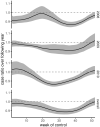Linking mosquito surveillance to dengue fever through Bayesian mechanistic modeling
- PMID: 33226987
- PMCID: PMC7721181
- DOI: 10.1371/journal.pntd.0008868
Linking mosquito surveillance to dengue fever through Bayesian mechanistic modeling
Abstract
Our ability to effectively prevent the transmission of the dengue virus through targeted control of its vector, Aedes aegypti, depends critically on our understanding of the link between mosquito abundance and human disease risk. Mosquito and clinical surveillance data are widely collected, but linking them requires a modeling framework that accounts for the complex non-linear mechanisms involved in transmission. Most critical are the bottleneck in transmission imposed by mosquito lifespan relative to the virus' extrinsic incubation period, and the dynamics of human immunity. We developed a differential equation model of dengue transmission and embedded it in a Bayesian hierarchical framework that allowed us to estimate latent time series of mosquito demographic rates from mosquito trap counts and dengue case reports from the city of Vitória, Brazil. We used the fitted model to explore how the timing of a pulse of adult mosquito control influences its effect on the human disease burden in the following year. We found that control was generally more effective when implemented in periods of relatively low mosquito mortality (when mosquito abundance was also generally low). In particular, control implemented in early September (week 34 of the year) produced the largest reduction in predicted human case reports over the following year. This highlights the potential long-term utility of broad, off-peak-season mosquito control in addition to existing, locally targeted within-season efforts. Further, uncertainty in the effectiveness of control interventions was driven largely by posterior variation in the average mosquito mortality rate (closely tied to total mosquito abundance) with lower mosquito mortality generating systems more vulnerable to control. Broadly, these correlations suggest that mosquito control is most effective in situations in which transmission is already limited by mosquito abundance.
Conflict of interest statement
The authors have declared that no competing interests exist.
Figures




Similar articles
-
Dengue and yellow fever virus vectors: seasonal abundance, diversity and resting preferences in three Kenyan cities.Parasit Vectors. 2017 Dec 29;10(1):628. doi: 10.1186/s13071-017-2598-2. Parasit Vectors. 2017. PMID: 29284522 Free PMC article.
-
A high-risk Zika and dengue transmission hub: virus detections in mosquitoes at a Brazilian university campus.Parasit Vectors. 2018 Jun 22;11(1):359. doi: 10.1186/s13071-018-2883-8. Parasit Vectors. 2018. PMID: 29929561 Free PMC article.
-
Surveillance of Aedes aegypti indoors and outdoors using Autocidal Gravid Ovitraps in South Texas during local transmission of Zika virus, 2016 to 2018.Acta Trop. 2019 Apr;192:129-137. doi: 10.1016/j.actatropica.2019.02.006. Epub 2019 Feb 11. Acta Trop. 2019. PMID: 30763563
-
Vector dynamics and transmission of dengue virus: implications for dengue surveillance and prevention strategies: vector dynamics and dengue prevention.Curr Top Microbiol Immunol. 2010;338:115-28. doi: 10.1007/978-3-642-02215-9_9. Curr Top Microbiol Immunol. 2010. PMID: 19802582 Review.
-
Production, Transmission, Pathogenesis, and Control of Dengue Virus: A Literature-Based Undivided Perspective.Biomed Res Int. 2021 Dec 15;2021:4224816. doi: 10.1155/2021/4224816. eCollection 2021. Biomed Res Int. 2021. PMID: 34957305 Free PMC article. Review.
Cited by
-
A symbiotic gut bacterium enhances Aedes albopictus resistance to insecticide.PLoS Negl Trop Dis. 2022 Mar 4;16(3):e0010208. doi: 10.1371/journal.pntd.0010208. eCollection 2022 Mar. PLoS Negl Trop Dis. 2022. PMID: 35245311 Free PMC article.
-
Metagenomic Insight into the Microbiome and Virome Associated with Aedes aegypti Mosquitoes in Manado (North Sulawesi, Indonesia).Infect Dis Rep. 2023 Sep 11;15(5):549-563. doi: 10.3390/idr15050054. Infect Dis Rep. 2023. PMID: 37737001 Free PMC article.
-
Laboratory Findings in Patients with Probable Dengue Diagnosis from an Endemic Area in Colombia in 2018.Viruses. 2021 Jul 19;13(7):1401. doi: 10.3390/v13071401. Viruses. 2021. PMID: 34372606 Free PMC article.
-
Investigating the Determinants of Dengue Outbreak in Oman: A Study in Seeb.J Epidemiol Glob Health. 2024 Dec;14(4):1464-1475. doi: 10.1007/s44197-024-00324-3. Epub 2024 Nov 4. J Epidemiol Glob Health. 2024. PMID: 39495476 Free PMC article. Review.
-
Knowledge, Attitude and Practices Towards Dengue Fever Among Slum Dwellers: A Case Study in Dhaka City, Bangladesh.Int J Public Health. 2023 May 22;68:1605364. doi: 10.3389/ijph.2023.1605364. eCollection 2023. Int J Public Health. 2023. PMID: 37284509 Free PMC article.
References
-
- Scott TW, Morrison AC. Longitudinal field studies will guide a paradigm shift in Dengue prevention In: Vector Biology, Ecology, and Control; 2010. p. 139–161. http://link.springer.com/10.1007/978-90-481-2458-9. - DOI
-
- Scott TW, Morrison AC. Vector dynamics and transmission of dengue virus: implications for dengue surveillance and prevention strategies. Dengue Virus. 2010;(338):161 - PubMed
Publication types
MeSH terms
Associated data
LinkOut - more resources
Full Text Sources
Medical

